Choosing rod holders and adding them to your kayak is the first step in personalizing your ride. Before heading to the paddle shop, consider where and how you fish, and plan your rod holder purchase accordingly. There are a myriad of options suited to all different styles of anglers.
For trolling, flush mount rod holders are strongest. To fish in rivers and ponds with overhanging trees, look for horizontal rod holders. Vertical holders are best for carrying multiple rods. To keep the rods away from the water and in reach, attach an adjustable rod holder to a gear track or deck mount. Rod holders behind the seat are mostly for transportation; place holders ahead of the seat for fishing.
Read on for installation tips, best brands and rod holder reviews. We break down the key distinctions to help you get the right type of rod holder and the particular model best suited to you.
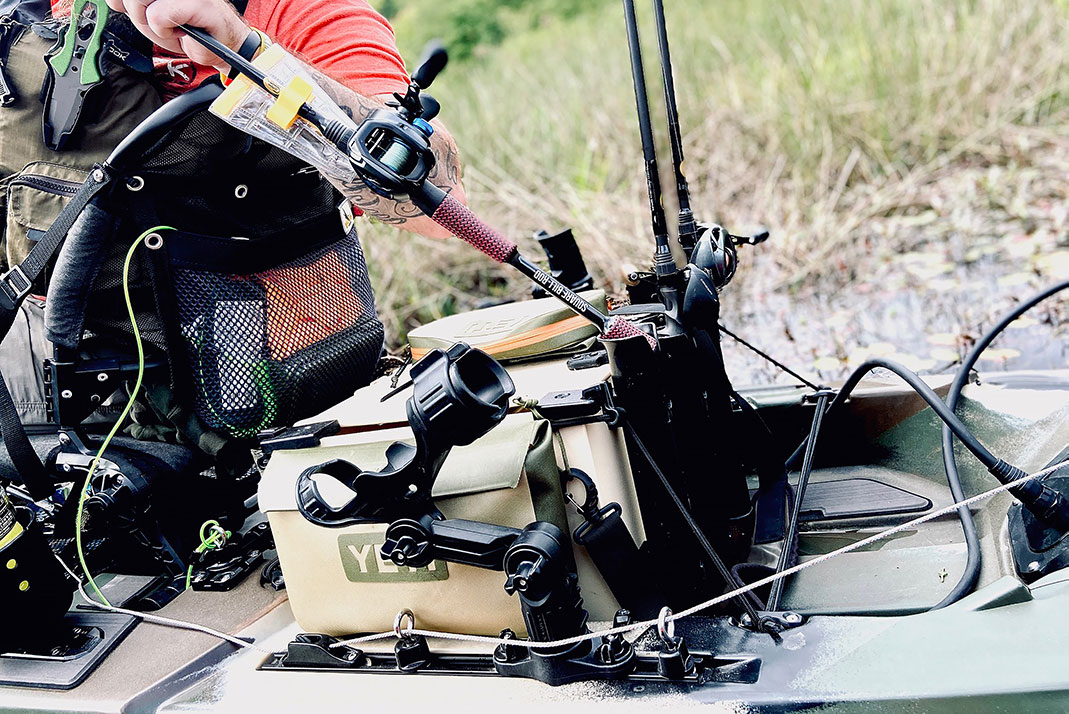
Types of Rod Holders
Adjustable Rod Holders
For the ultimate in utility, adjustable, elevated rod holders can be configured for the perfect placement and function. An adjustable rod holder is best to hold the rod while rigging lures or moving between spots.
The primary objective of an adjustable rod holder is to keep the reel farther away from the water and closer to the angler. On most elevated rod holders, the neck is adjustable and the base can be mounted almost anywhere on the kayak. Many rod holders have a base to connect to a gear track. This allows the rod holder to move fore and aft and change places on the boat. Other adjustable rod holders are mounted with a stronger permanent base.
An adjustable rod holder can be angled in any direction, so it will serve as a vertical or horizontal rod holder. Adjustable rod holders come in a variety of sizes and configurations. Long, short, angled, straight, heavy duty, light weight—there’s an adjustable rod holder for every need.
Installation: If the underside of the location is accessible, use stainless steel bolts and lock nuts to attach the base. If the underside is not accessible, attach the base with pop rivets or self-tapping screws. Use the base as a templet to drill the holes, then add a bead of silicone around the edge of the base.
Pros: Adjustable length and angle. Fixed or track mounting. Elevates rods away from the water.
Cons: Weaker connection. Can impede casting, paddling or entering the kayak.

Flush mount rod holders
Flush mount rod holders are the strongest choice. The rod tube is below deck with the collar close to the reel, so it it stays out of the way and provides the maximum support for trolling or fishing bait. On the down side, flush mounts require drilling a two-inch hole in the deck. And, they can’t be adjusted or removed.
Flush mounts are best for trolling or bait fishing, especially when you’re expecting a big bite. Angle the rod holder to point the rod tip away from the boat. Done right, flush mount rod holders will be the strongest rod holders on the boat.
Installation: Flush mount rod holders are most often installed behind the seat and ahead of the cockpit. Before installing a flush mount, measure the space below the deck to be sure it will accommodate the rod holder. Seal the bottom of the rod tube with a trailer bearing dust cover and bead of silicone sealant. Use a hole saw to drill a two-inch hole in the plastic. Run a bead of sealant around the edge of the collar and attach the rod holder to the deck with stainless steel bolts and lock nuts.
Pros: Low profile. Stronger connection.
Cons: Requires cutting a hole in the kayak. Permanent installation.
Vertical rod holders
Use a vertical rod holder to carry rods to and from the fishing grounds. Four to six vertical rod holders behind the seat keep rods organized and out of the way. Add rod leashes or bungees to secure the rods in the kayak.
Vertical rod holders are often attached to a crate or live well. Don’t leave the rod in a vertical rod holder while fishing—a fish could yank the rod overboard or break the rod holder.
Installation: For a DIY solution, a simple two-foot section of two-inch PVC tubing cable tied to a milk crate will get you to the fishing grounds. For a more secure connection, a molded plastic rod holder offers the advantage of a notch to hold the reel. Attach the rod holder with a stainless steel 10-32 bolt, a large washer and lock nut.
Pros: Best for transporting rods to the fishing grounds. Keeps rods out of the path of casts and paddle strokes.
Cons: Not angled or adjustable.
Horizontal rod holders
Horizontal rod holders are a must-have for anglers dragging their kayak through heavy cover to an isolated launch or paddling through thick brush to reach a hidden fishing hole. To keep rods from snagging in overhanging trees and bushes, secure them parallel to the deck. To keep lines and lures from tangling, limit the number of fishing rods.
Installation: A simple solution is to add a couple pad eyes to the deck and use a six-inch bungee to hold the rods. Secure two pad eyes near the seat and two near the bow with pop rivets, bolts or self-tapping screws. Tie a six-inch length of bungee to one pad eye and use a hook to attach it to the other pad eye.
Pros: Keeps rod tips out of overhangs and trees. Easy to install. Requires open deck.
Cons: Takes up space. Lines and lures tangle.
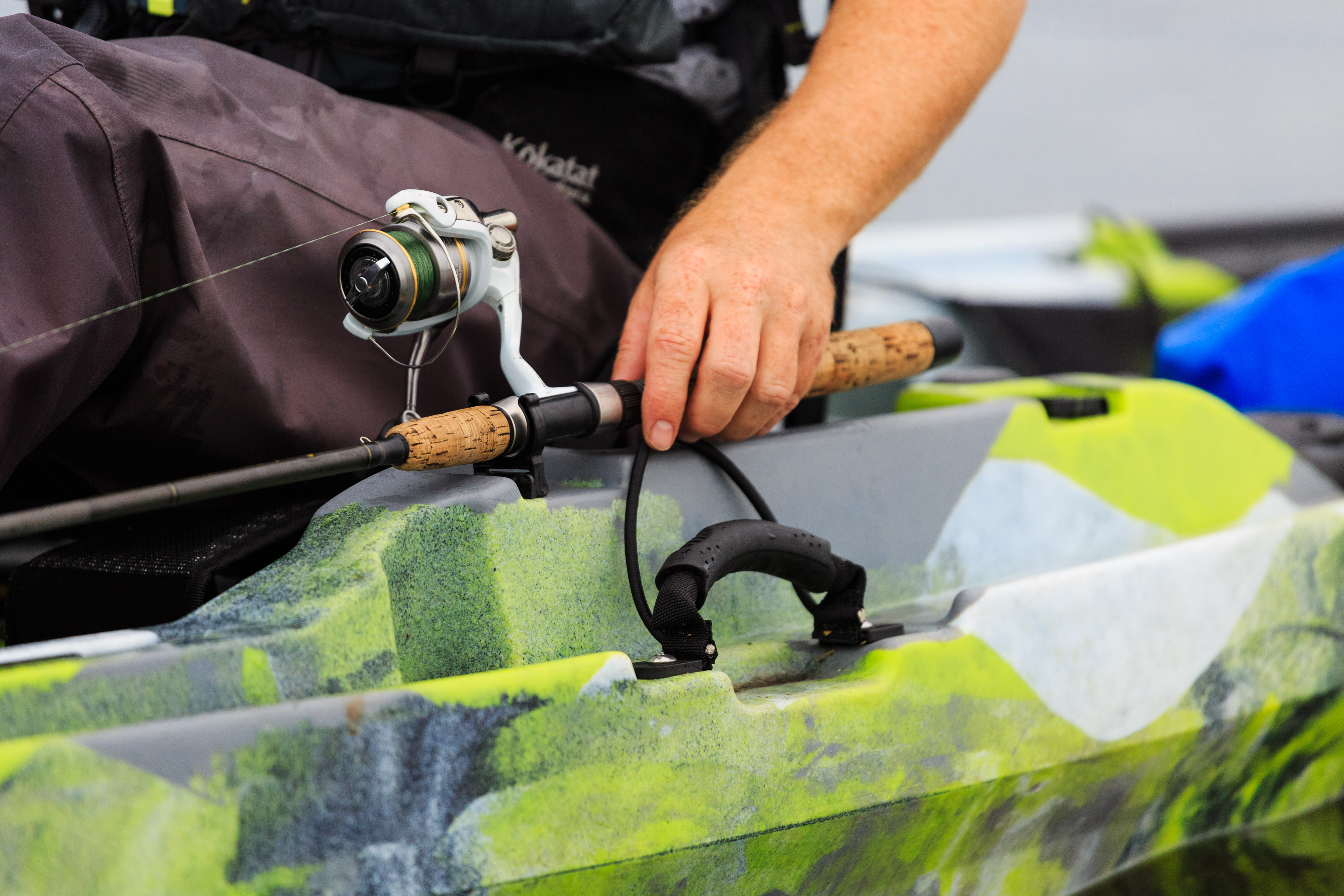
Where to Put Rod Holders on a Kayak
- Keep out of way of paddling and casting.
- Do not impede entry, especially after a wet exit.
- Measure twice, drill once.
How to Install Rod Holders on a Kayak
- Install a backing plate to provide additional support.
- If you can reach the inside of the hull, use stainless steel bolts and lock nuts.
- If you can’t reach the inside of the hull, use pop rivets. Self-tapping screws are less secure than rivets, but easier to install and remove.
- Close the bottom of a flush mount rod holder with a rubber bearing cap for a trailer hub.
- Fold adjustable rod holders flat for transport.
- Seal all holes with marine adhesive.
- Trace the base on paper or cardboard and cut out a template.
Kayak Rod Holder Brands
Rod Holder Reviews and Gear Previews
RAM Mounts Rod Holders
Scotty Rod Holders
Stealth QR2 Rod Holder
YakAttack Zooka II Rod Holder
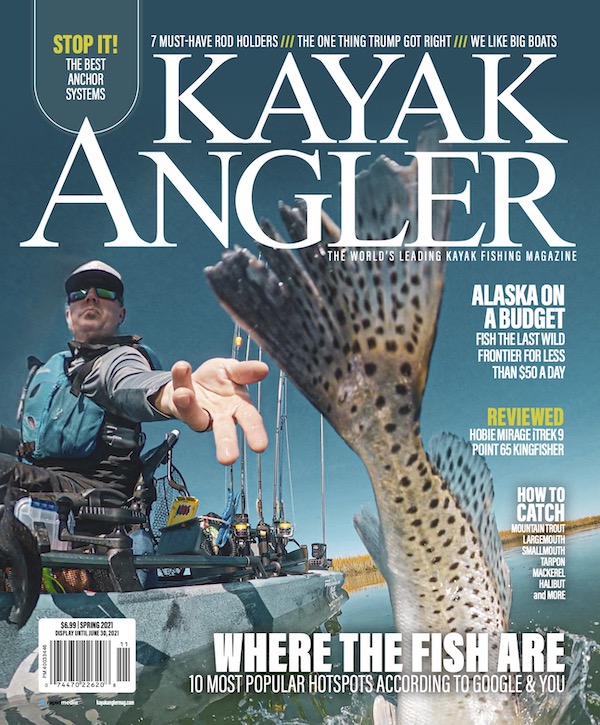 This article was first published in Kayak Anger Issue 44. Subscribe to Kayak Anger and get the magazine delivered to your front door. Download the Kayak Angler Magazine+ app to seamlessly glide between the digital archives, the latest articles and videos or browse the digital archives for your desktop here.
This article was first published in Kayak Anger Issue 44. Subscribe to Kayak Anger and get the magazine delivered to your front door. Download the Kayak Angler Magazine+ app to seamlessly glide between the digital archives, the latest articles and videos or browse the digital archives for your desktop here.
An adjustable rod holder elevates the rod away from the water. | Feature Photo: Brad Hole

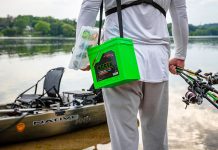
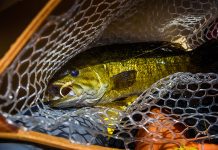




I typically use scotty style rod holders and keep them horizontal. With low profile mounts. So old school scotty #279 because of the small size in terms of overall diameter and height Track mounted on my kayak. I use the scotty 415 slip disks and the scotty 438 track adapters with them. If you want to keep rods horizontal and low this is the best I’ve found for now.
I river kayak fish 95% of the time. I need to be able to get into overhangs well without creating a Christmas tree when retrieving a lure or when fishing the edges during high water. Often the water is up in the woods during that time. I also need to be able to nose in and out against brush. Vertical rods off the back create a special challenge.
Horizontal mountings up front have a trade off though as it’s not as easy to swing your legs over to either control attitude during a drift or simply getting in and out. So as usual there is a trade off.
The other mounts that have other capabilities say Power Locks, Orcas, Omega Pro, Stealth QR-1 have issues. Mostly due to height, bulk and ability to keep the rods low and horizontal once in the mount. ESPECIALLY with balanced rods (weighted in the back). If you balance your rods and have your handles weighted the tips will rise in the mount and stick up at weird angles. The wider diameter of the holder allows for more room for this even when strapped in. I’ve tried them all. QR-1 though promising – which I am trialing now included.
Old school scotty #279 are still the best for my purpose.